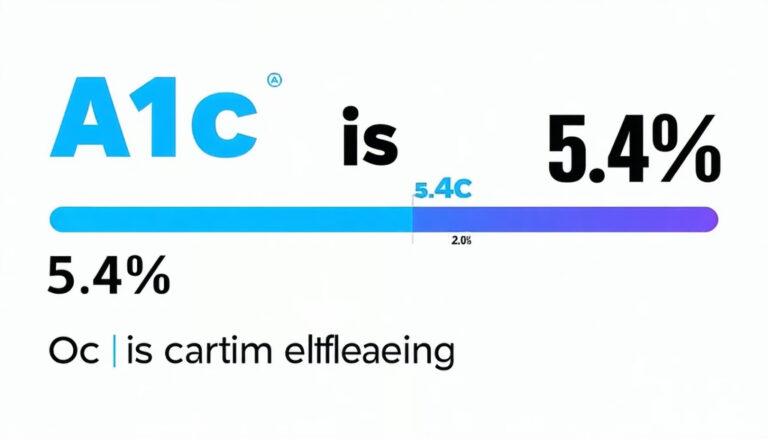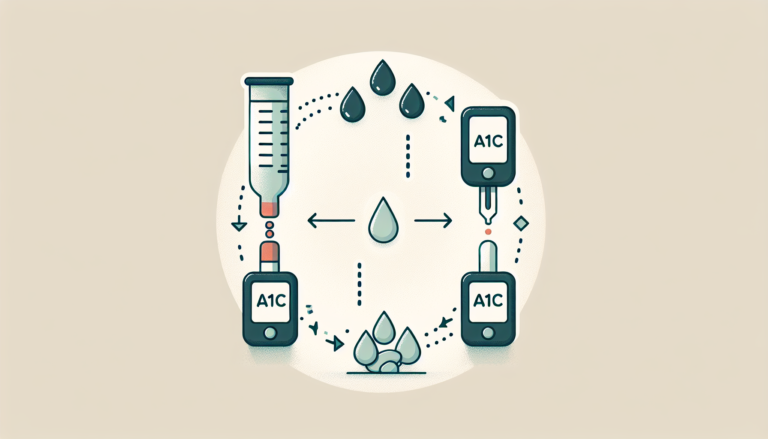A1C Untangled: Our Guide to Managing Levels in LADA Diabetes
Discover how to manage A1C levels in LADA diabetes with our friendly guide. Get tips, insights, and future perspectives!
Understanding A1C Levels
When dealing with latent autoimmune diabetes in adults (LADA), hitting the books on A1C levels is key. Keeping tabs on these numbers helps us understand just how well we’re managing blood sugar over time and tweak our game plan if needed.
Importance of A1C Testing
So, what’s the big deal with the A1C test, also called the hemoglobin A1C test? It’s like a report card for your blood sugar covering the last 2-3 months. Anyone with LADA needs this info because it gives us a bird’s-eye view of blood sugar control. This helps us fine-tune meds, evaluate insulin therapy, and ward off complications.
Regular A1C testing is our compass for gauging how we’re doing with the broader blood sugar management. If A1C levels creep higher, it’s a red flag that changes are needed, maybe even shifting gears in the treatment plan.
A1C Levels in LADA
Folks with LADA usually show up with A1C numbers over 7.0% when first diagnosed, unlike those with type 2 diabetes. Why? Well, LADA likes to ramp things up, causing blood sugar havoc, and leading people toward insulin before type 2 ever would (Dexcom, PubMed Central).
| Patient Group | A1C Level at Diagnosis (%) |
|---|---|
| Type 2 Diabetes | < 7.0 |
| LADA | > 7.0 |
Research backs this up, showing LADA’s fast track to insulin needs due to the immune system gradually damaging the insulin-making cells in the pancreas. This ongoing beta-cell damage means less insulin over time.
Keeping an eye on A1C is critical for LADA patients because it helps us monitor what’s left of those hardworking β-cells. LADA folks still have some β-cell activity early on, but C-peptide levels (a marker of insulin production) decline at a slower pace compared to type 1 diabetes. Pairing A1C tests with C-peptide checks helps us size up LADA and adjust the treatment.
Need more nitty-gritty on managing A1C in LADA? Swing by our articles on managing a1c in lada and a1c test for lada patients.
Grasping what A1C levels mean in the LADA context equips us to better handle and anticipate the diabetes journey ahead. Constant A1C checks are the backbone of shaping our treatment tactics and keeping blood sugar in check. For more help with A1C readings, visit our guide on understanding a1c results in lada.
LADA Diabetes Overview
Definition of LADA
Latent autoimmune diabetes in adults, or simply LADA, is a sneaky type of diabetes that often starts showing up when we’re more “grown-up” and then gets worse slowly. Basically, the immune system decides it wants to bully some of the pancreas’s insulin-making cells, much like what goes down in type 1 diabetes. But it drags its feet a bit, leading to a slower progression.
Key Differences from Type 1 and Type 2
LADA is like that oddball cousin in the family who’s got traits from both sides. Recognizing these quirks helps us spot LADA early on and handle it better.
Clinical Features
Folks with LADA might show a mix of symptoms from both type 1 and type 2 diabetes. Typically, they’re older than typical type 1 folks when they get diagnosed, and they’re often slimmer than type 2 patients. You might see their immune system throwing shade at the pancreas with different kinds of antibodies like islet cell autoantibodies and insulin autoantibodies.
| Feature | Type 1 Diabetes | Type 2 Diabetes | LADA |
|---|---|---|---|
| Age at Onset | Younger Years | Mid-Life Crisis | Adult Life |
| BMI | Normal-ish | Heavier Side | Usually Slimmer |
| Antibodies | A Thing | Nope | Big Yes |
| Onset Speed | Quick | Eventually | Taking Its Time |
| Insulin Needs | Right Away Now | Wait and See | Sooner or Later |
Beta-Cell Dysfunction and Insulin Resistance
When it comes to beta-cell drama, LADA sits somewhere between type 1 and type 2 diabetes but has a bit of a faster decline in C-peptide levels than type 2. Insulin resistance? LADA walks hand-in-hand with type 1 in that department.
Glycemic Control
Balancing blood sugar can get tricky for those with LADA, and they often find it tougher than those with type 2. They tend to experience poorer glycemic control over time. For juicy details on keeping A1C levels in check, check out our guide on managing a1c in lada.
Genetic Components and Antibodies
There’s some science behind it—genetic factors play a part in LADA, with insulin antibodies sometimes flagging it. Roughly 4-14% of adults told they have type 2 diabetes might actually have LADA. Want to know how these details mess with A1C levels? Peek into our articles on a1c test for lada patients and understanding a1c results in lada.
By digging into what sets LADA apart from type 1 and type 2 diabetes, we can make a better game plan for managing those tricky A1C readings in LADA diabetes.
Diagnosis and Management of LADA
Misdiagnosis Challenges
When it comes to diabetes, Latent Autoimmune Diabetes in Adults (LADA) can really throw a wrench in the works. It’s often mixed up with Type 2 diabetes because their symptoms look a lot alike. Folks with LADA tend to be slimmer and get diagnosed at a younger age than those with Type 2 diabetes (NCBI). Add a temporary positive reaction to oral meds, and it’s easy to see why doctors might stick the wrong label on things, which is a major bummer when you’re itching for the right treatment.
The real kicker with confusing LADA for Type 2 diabetes is that folks get pushed towards pills and healthy living tweaks, putting off the vital insulin therapy they truly need. Meanwhile, their A1C—basically the blood sugar report card—stays too high, leading to potential long-term troubles. Pinpointing the right diagnosis is crucial, and it involves looking for those sneaky autoantibodies and checking C-peptide levels.
Treatment Approaches and Progression
Once LADA’s correctly flagged, reigning in those A1C levels is a beast of a task. With LADA being an autoimmune gig, most people need to hop on insulin therapy way quicker than your typical Type 2 case. Truth is, the majority of folks with LADA are on insulin within five years (PubMed Central).
Treatment plans have gotta stay on their toes, given how LADA likes to play rough. Those oral meds might do the trick at first, but they’re usually not enough as insulin production takes a nosedive. Getting insulin into the picture sooner can really help keep A1C on a leash.
Another hot ticket for LADA is Glucagon-like peptide 1 receptor agonists (GLP-1RA), which play nice with metabolic control. But don’t get too comfy—these guys might not work wonders if your fasting C-peptide numbers are low. While GLP-1RA has its perks, keeping a close watch and tweaking your treatment is a must.
LADA frequently tags along with other autoimmune drama, especially in thyroid land, messing with diabetes management big time (NCBI). Keeping an eye on things with a sharp and all-around plan that includes regular A1C check-ins is the way to nail effective management.
| Treatment Option | How Well it Works out with LADA |
|---|---|
| Oral Medications | Good at first, not so much down the road |
| Insulin Therapy | Needed in a few years, vital for keeping A1C numbers sane |
| GLP-1RA | Has its moments, but varies with those fasting C-peptide levels |
For a deeper dive on what those A1C readings really mean, don’t miss our guide on understanding a1c results in lada or learn more about the a1c test for lada patients.
Future Perspectives in LADA
Research on LADA Management
Research into managing those stubborn A1C levels in LADA diabetes is making waves, and it’s looking like some pretty interesting treatments could be on the horizon.
- GLP-1 Receptor Agonists (GLP-1RA) So, GLP-1RA is the cool kid on the block. These can really help folks with LADA take control of their sugar levels. But here’s the kicker—if your fasting C-peptide levels are low, the magic might be a little dim. We definitely need some big boy studies to see how these work in the long run and if they can keep folks off the insulin train for a bit longer (source).
- DPP-4 Inhibitors (DPP-4i) Then there’s DPP-4i. Imagine it as your insulin’s potential BFF. We’re curious if these can help your body keep making its own insulin. But, of course, more research is our go-to phrase here—it’s like the Netflix cliffhanger of diabetes management (ADCES Connect).
Potential Therapies and Lifestyle Modifications
- SGLT2 Inhibitors (SGLT2i) Now, SGLT2i could be a game changer—better sugar control without those pesky hypoglycemic episodes. But, there might be a sneaky risk of ketoacidosis if your C-peptide levels aren’t great, so tread carefully (source).
- Lifestyle Modifications Let’s face it, lifestyle changes are the unsung heroes in this story. Everything from shaking off those extra pounds, ditching the smokes, to skipping the soda is important. It’s like an old-school upgrade for your body.
| Therapy/Modification | Potential Benefits | Considerations |
|---|---|---|
| GLP-1RA | Sugar level hero | Might be shy with low C-peptide |
| DPP-4i | Insulin buddy? | We need more clues |
| SGLT2i | Sugar control without lows | Watch out for ketoacidosis |
| Lifestyle Changes | Health upgrade | Needs dedication |
Want to dig deeper? Our info-packed article on understanding A1C results in LADA will perk your interest, and don’t miss the scoop on the A1C test for LADA patients—it’s a must-read for getting what’s going on with those test numbers.








Leave a Reply